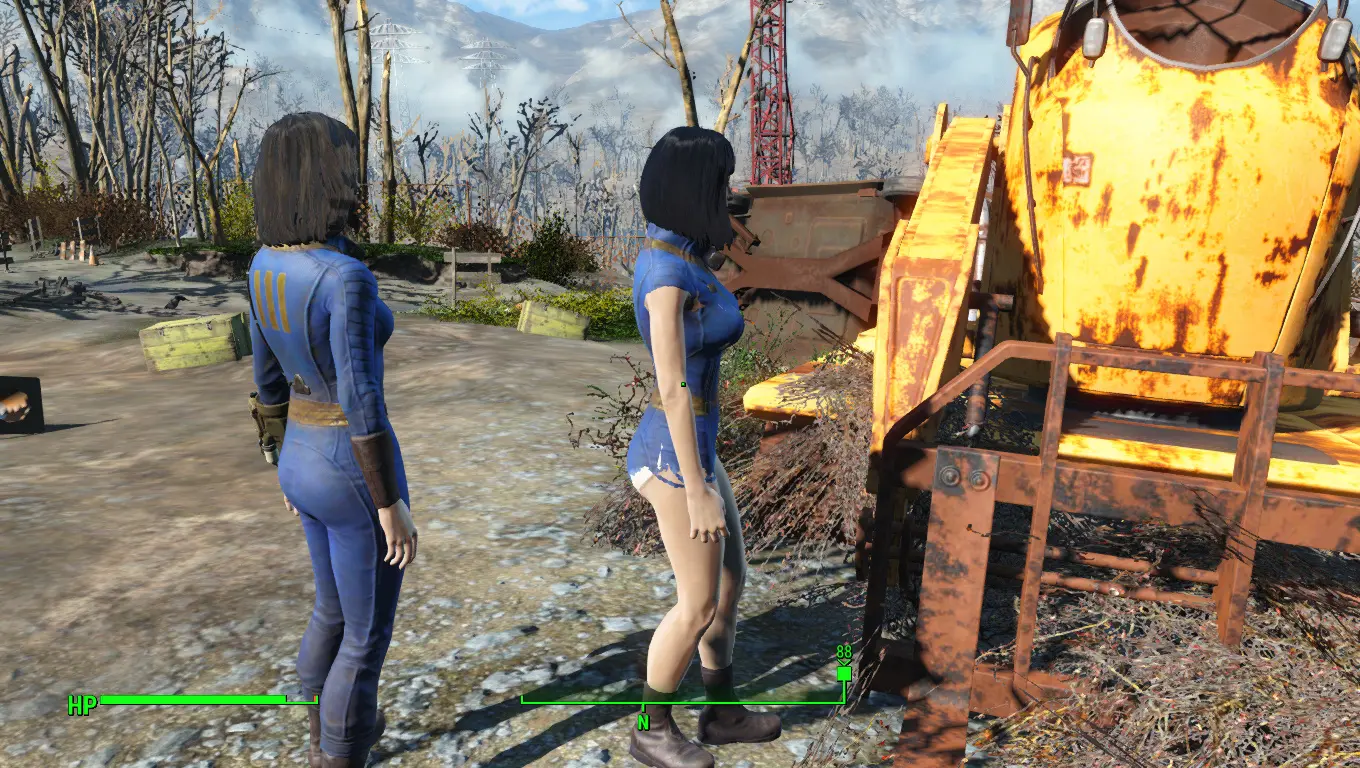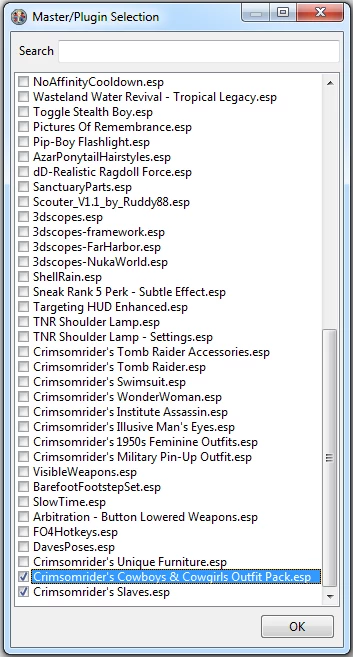Sort with LOOT 3. Create merged patch (right click bottom plugin in load order and choose merge. When Fallout 4‘s Creation Kit initially released. As mentioned up top, I used to run the game with 250 mods active — although I did learn to merge ESP files just to be below the limit.
Jun 28, 2016 Load TES5edit with the ETAC patch selected and wait until background loader has finished. Then click the + in front of the ETAC patch click on 'File Header'. On the right panel search for the master esp you want to rename and right click and then 'Edit'. Rename it to the file name in the CR (the Nsutr merge) and OK. For example 'existingModFromNexus.esp' and rename the ba2 as 'existingModFromNexus - Textures.ba2', would that work? I can't merge the archives (filesize would be too big, they are retextures) so I guess I will have to make a plug-in for every ba2 archive, though that would defeat the whole purpose of making ba2 archives. Merge Plugins: Start to Finish Easy. What makes this Tutorial worth watching? Read on: Merge Plugins: http://www.nexusmods.com/sk.
'The Method as such is about getting human eyes, as effectively and with as little redundancy as possible, on every conflict. It doesn't explicit tell you how to recognize and fix conflicts that you then see. That's something you'll have to learn as you go along and for which is pretty much impossible to create clear step by step rules for anyone to follow.'

- ElminsterAU, original developer of xEdit
IMPORTANT NOTES:
This guide assumes that you are already familiar with manual conflict resolution using xEdit. It also assumes that you are competent enough to check the author-advised requirements, possible conflicts, and installation instructions of any mods you install. It is on YOU to properly follow the instructions for whatever you install!
Script and NavMesh conflicts, while being relatively uncommon, are more difficult to resolve and require use of the appropriate Creation Kit/GECK for the game you're working with, and thus are beyond the scope of this guide. If you come across such a conflict, look it up first! Trying to fix it yourself without knowing what you're doing has a 99.999% chance of breaking whatever you're working on.
So far only Skyrim Special Edition and Fallout 4 support the ESL flag - however, one can still follow this guide for Fallout 3, Oblivion, New Vegas, and Skyrim Legendary Edition, with a few minor differences:
DO NOT clean masters for Fallout 3 or New Vegas! This will break your game.
Instead of flagging your micropatches as ESL, keep them as normal .esp files and merge them either by hand in xEdit, or using a tool such as zMerge (recommended for merging 254 plugins or less) or Wrye Bash with only the merge plugins options enabled (advanced users only). Launching xEdit with the parameter
-pseudoESLwill show you which files could in theory be safely flagged as ESL, and thus are also safe to merge. Whenever using an automated tool to generate a module of some kind, ALWAYS go over it by hand in xEdit to make sure everything is as it should be. No exceptions.IT IS ON YOU TO RESEARCH HOW TO PROPERLY SET UP EACH GAME! This guide is simply an overview of the best technique for conflict resolution - it does NOT include instructions on which mods to install (except the Unofficial Patch for SSE/FO4), or how to properly install them.

Start with a completely fresh load order. Install the Unofficial Patch and launch xEdit.
Select all the modules in the list on the left, open the context menu, and select “Create ModGroup”. When prompted “Do you want to include the current CRC32s?”, select yes[1]. Enter an appropriate name in the field at the top (e.g. Main Masters), and hit OK.
- [1]: This makes it so that should any of the mods within the group be updated, the entire group will be disabled when loaded in xEdit. If this happens, check for any new conflicts within the mod group, deal with them as necessary, and then select the “Update CRC in ModGroups” option in the context menu of the module list.
In the next menu, when prompted “In which module’s .modgroups file should the new ModGroup be stored?”, select the Unofficial Patch and hit okay. Finally, when prompted “Which ModGroups do you want to activate?”, select the group you just made and hit OK.
Close xEdit, install your next mod of choice (ONE AT A TIME), and check to see if it added any modules (i.e. .esm, .esp, or .esl files). If not, keep installing your mods one at a time until a module is added. Launch xEdit again with the parameter
-veryquickshowconflicts, which can be added in the “…” menu of Mod Organizer, in the “Arguments” field for xEdit. This can be removed when you’ve finished making ModGroups, or you can make another entry specifically for it.Perform manual conflict resolution between any conflicting modules[2], including ITM (Identical To Master) and UDR (Undelete and Disable Records) cleaning where necessary[3].
[2]: When making manual patches which simply consist of overrides, it is recommend to use the template of an .esp file with the ESL flag. This makes it occupy a “light slot” rather than a “full slot”, thus maximizing the number of modules you can load at any one time.
[3]: Cleaning is easily accomplished using the
-quickautocleanparameter for xEdit. Simply load a module in xEdit using this parameter and allow it time to work, then close the program when finished and repeat for all modules which need cleaning. Do NOT attempt manual cleaning unless you know precisely what you are doing, and can fully explain why-quickautocleandoesn’t do the job for you.
In the View tab, when viewing a record with overrides from two or more modules (not including Skyrim.esm or equivalent), right click the name of a module in the banner along the top and select “Create ModGroup”. This will open the interface for creating a ModGroup, and prompt you to select which of the modules currently in the View tab you’d like to add to it – this should include your patch for the mod you’re currently resolving conflicts for, if you’ve made one. Alternatively, select the conflicting modules in the list on the left, right click to open the context menu, and select “Create ModGroup” from there.
- [4]: Ideally, ModGroups should be made as small possible, including the fewest possible modules while still properly dealing with all conflicts. Doing this ensures greater freedom to disable individual modules without introducing false positives to xEdit’s conflict filter.
Just as with the first ModGroup you made for the Unofficial Patch and the game itself, click yes to CRC32s, and name the group appropriately[5].
- [5]: Pressing Ctrl+N while having a module selected will set the name of the ModGroup to the name of the module, without the extension.
Before hitting OK, assign the appropriate flags to each module within the ModGroup by clicking on the tiles to the right of each module’s name. The different kinds of flags are as follows:
Optional: If a module is flagged as “Optional”, the ModGroup will load regardless of if it’s missing.
Target: If a module is flagged as “Target”, its override records are hidden if it loses a conflict to a module further down within the ModGroup.
Source: If a module is flagged as “Source”, an override record within it will cause the overrides with the same FormID to be hidden from all modules flagged as Target and listed above this Source in the ModGroup.
Forbidden: If a module is flagged as “Forbidden” and loaded in to xEdit, its respective ModGroup is automatically disabled until the module itself is disabled.
Ignore LO:
If not flagged, then the module must be loaded in the same order as listed in the ModGroup.
If flagged as “Always”, the ModGroup will load as long the module is present, regardless of load order.
If flagged as “In Block”, all consecutive modules which share this flag will form a block. Any module above the block must be loaded before any module in the block. Any module after the block must be loaded after any module in the block. The modules inside the block can load in any order
Once finished assigning flags, hit OK to go the next menu. Store the ModGroup with the module which does the most conflict solving[6], and hit OK.
- [6]: ModGroups are best saved with the module which corrects, or overwrites, whatever you want fixed. For example, in a conflict between two modules, even if you don’t make a patch because you’re satisfied with the way the overwrites occur, saving the ModGroup with the latter-loading module ensures that the relevant ModGroup is only active when the overwriting module is present. This ensures that conflicts will be detected when the overriding module, often a patch, is absent. Note that multiple ModGroups can be stored with a single module.
Continue creating ModGroups and manual patches as required to resolve all conflicts reported by xEdit for the module you’ve loaded[7]. You’ll know this is the case when the tree-view in the left pane of xEdit is empty after running the conflict filter, which can be refreshed by right clicking said pane and selecting “Apply Filter to show Conflicts” from the context menu.
- [7]: If adding a new module results in lots of conflicts showing up, you may find it useful to hold the Ctrl key when launching xEdit through Mod Organizer with the
-veryquickshowconflictsparameter. This allows you to choose which modules you want to load, which can make it easier to resolve one conflict without seeing all the others.
- [7]: If adding a new module results in lots of conflicts showing up, you may find it useful to hold the Ctrl key when launching xEdit through Mod Organizer with the
Repeat steps 4 to 10 until you’ve finished installing all your mods, and xEdit reports no more conflicts. You might like to remove the
-veryquickshowconflictsparameter from xEdit in Mod Organizer if you chose not to make another entry for it.
I’ve seen a lot of people having trouble installing mods manually lately, especially people who don’t own flat Fallout 4 for reference. The information people post is usually very partial. I pieced together what I could, and everything seems to be working alright. Please let me know if I’ve missed anything!
- The first step for modding any Bethesda game is Archive Invalidation. To implement this here, edit this file:
Documents/My Games/Fallout4Vr/Fallout4VrCustom.ini
I think this file is created after running the game once, but if it doesn’t exist you can just create it. Add the following:
[Archive]
sResourceDataDirsFinal=
bInvalidateOlderFiles=1
Note: I’ve seen some posts instructing people to list your modded directories for the DataDirs value, but according to flat Fallout 4’s Archive Invalidation page, doing so is unnecessary and can drastically increase loading times.
- Drop your mod files into the following folder:
Steam/steamapps/common/Fallout 4 VR/Data/
This should be any files included with the mods, such as .esp, .esm, .ba2, or directories.
How To Merge Esp Files Fallout 4 Edition
- Edit the following file:
%localappdata%/Fallout4VR/Plugins.txt
which is the same as the following absolute path:
C:/Users/YOUR_USERNAME/AppData/Local/Fallout4VR/Plugins.txt
This is where a lot of people are having problems. This file doesn’t exist by default but it’s just a text file and you can create it manually.
Add the full filenames of any .esp or .esm files (including the file extension) you put in the Data/ folder in the previous step. This makes Fallout aware of those files.
- Still in the plugins.txt file, put an asterisk (*) at the beginning of each filename you want to be active. This tells Fallout to load these files in-game.

Fallout 4 Ini File
And you’re done! Pretty sure that’s all the steps. It’s been working for me so far but I’ve only installed a handful of mods.

For reference, my plugins.txt looks like this:
*Insignificant Object Remover.esp
*Remove Overweight Cant Run Message.esp
*Vivid Fallout – All in One – Best Choice.esp

Esp Files Downloads
And a bonus: If you want to tweak different settings, rather than crawling .ini files and guessing at variables I highly recommend /u/bilago‘s configuration tool, which lists all the values used in the engine and edits them for you, as well as including dedicated menus for some of the more important tweaks.